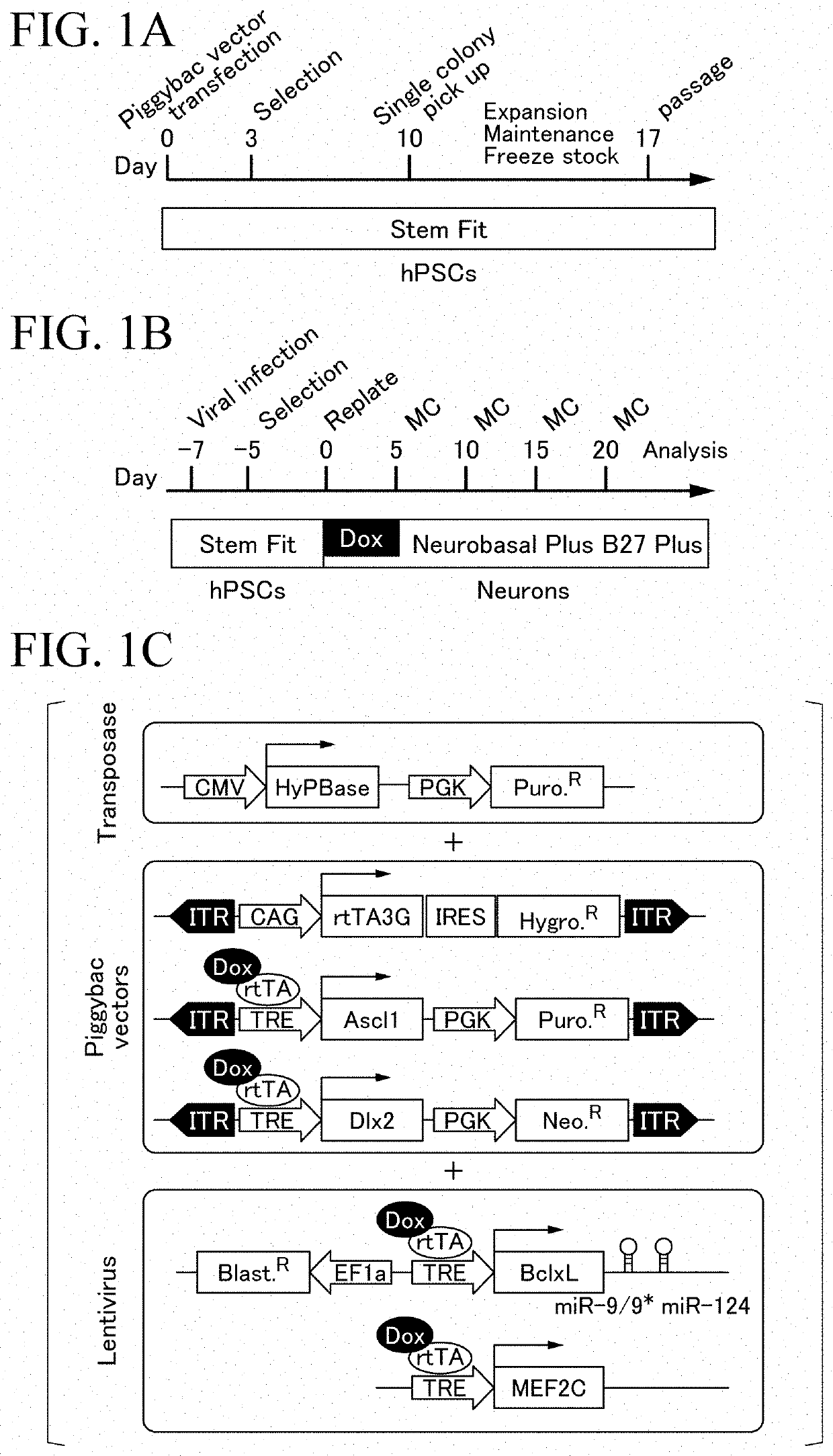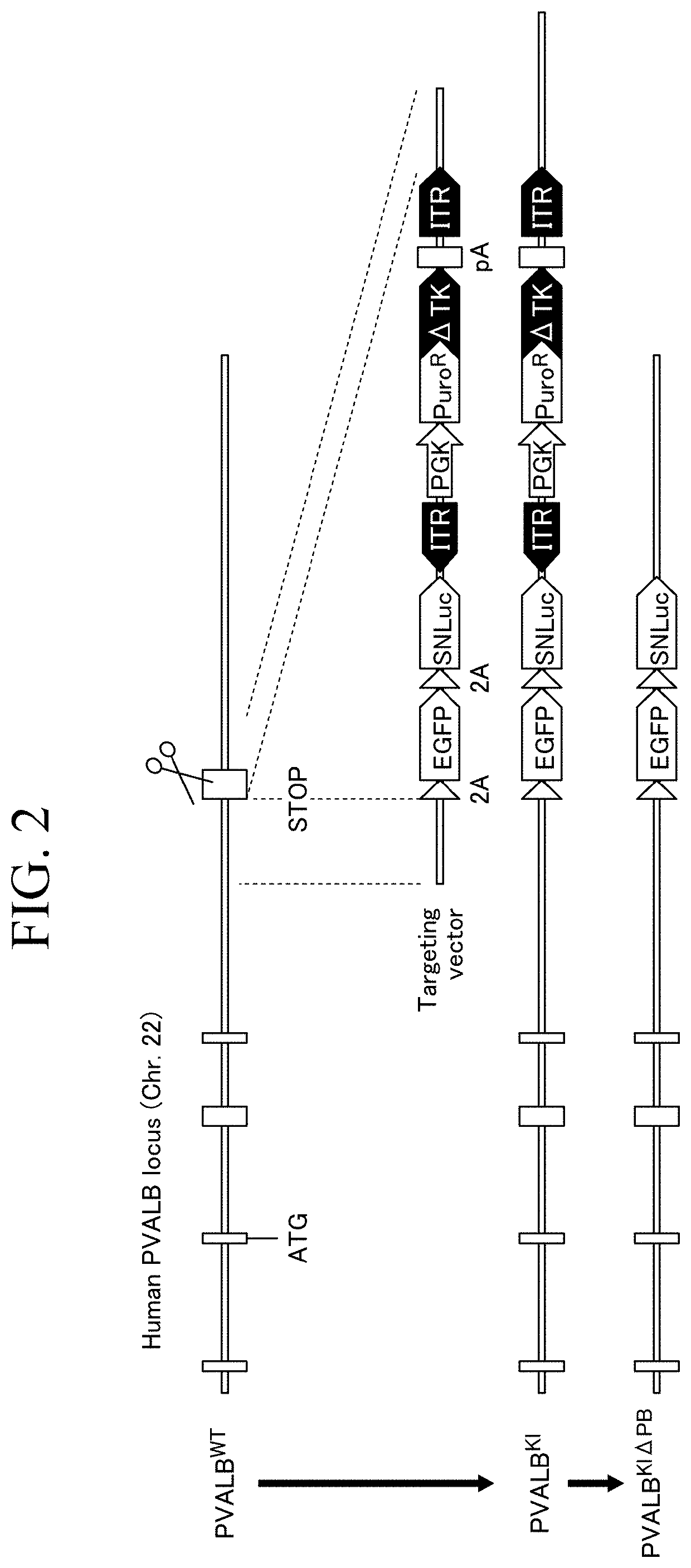Method for producing parvalbumin-positive nerve cells, cell, and differentiation inducer
- Summary
- Abstract
- Description
- Claims
- Application Information
AI Technical Summary
Benefits of technology
Problems solved by technology
Method used
Image
Examples
experimental example 1
[0057]Maintaining and Culturing iPS Cells
[0058]Culturing was carried out according to the known cell culture method published by the Kyoto University iPS Research Institute, except that iPS cells (1210B2 line) were set in a 6-well plate at an iPS cell seeding density of 1.5×104 cells / well at the time of cell transfer, pre-plate coating was not performed at the time of cell transfer, StemFit medium for undifferentiated cells (AK02N, manufactured by Ajinomoto Co., Inc.) including 1.5 mL of 10 μg / ml of ROCK inhibitor Y27632 (manufactured by Fuji Film Wako Pure Chemical Corporation) and 1.5 μg / ml iMatrix-511 (manufactured by Nippi, Inc.) was poured into a 6-well plate immediately before cell seeding at 1.5 ml / well, and direct cell seeding was performed.
experimental example 2
[0059]Introduction of Ascl1 Gene and Dlx2 Gene into iPS Cells
[0060]The scheme of introduction of Ascl1 gene and Dlx2 gene into iPS cells is shown in FIG. 1A. Specifically, the introduction of Ascl1 gene and Dlx2 gene into the iPS cells was performed as follows.
[0061](1) Preparation of Medium of Plate for Seeding Cells after Gene Introduction Operation and Coating Preparation
[0062]In a 6-well plate, 20 μg / ml of Y27632 (manufactured by Fuji Film Wako Pure Chemical Corporation) and 2.5 μg / ml of iMatrix-511 (manufactured by Nippi, Inc.) were added to StemFit (AK02N, manufactured by Ajinomoto Co., Inc.) and the result was placed in six well portions (one plate) at 2 ml / well and incubation was performed at 37° C. and 5% CO2.
[0063](2) Single cell of iPS cells iPS cells seeded to be approximately 1.5×104 cells / well in a 6-well plate were cultured for approximately one week in StemFit (AK02N, manufactured by Ajinomoto Co., Inc.), the medium was removed with an aspirator, and then the cells w...
experimental example 3
[0075]Introduction of MEF2C Gene, miRNA-9 / 9*, miRNA-124, and BclxL Gene into iPS Cells
[0076]The scheme of introduction of MEF2C gene, miRNA-9 / 9*, miRNA-124, and BclxL gene into the iPS cells is shown in FIG. 1B. Specifically, MEF2C gene, miRNA-9 / 9*, miRNA-124, and BclxL gene were introduced into the iPS cells as follows.
[0077](1) Purification of Lentiviruses into which MEF2C Gene, miRNA-9 / 9*, miRNA-124, and BclxL Gene were Introduced
[0078]In accordance with a normal method, as shown in the lower part of FIG. 1C, lentiviruses into which the MEF2C gene, miRNA-9 / 9*, miRNA-124, and BclxL gene were introduced were purified. Specifically, lentiviruses into which MEF2C gene, miRNA-9 / 9*, miRNA-124, and BclxL gene were introduced were purified as follows.
[0079]100 mm dishes for cell / tissue culture coated using a solution, in which a 0.01% Poly-L-Lysine solution (0.01%, #P4832, manufactured by Sigma) was mixed in PBS (−) at 1:100, were washed with PBS (−), and then HEK293T cells cultured semi...
PUM
| Property | Measurement | Unit |
|---|---|---|
| Time | aaaaa | aaaaa |
| Time | aaaaa | aaaaa |
Abstract
Description
Claims
Application Information
 Login to View More
Login to View More - R&D Engineer
- R&D Manager
- IP Professional
- Industry Leading Data Capabilities
- Powerful AI technology
- Patent DNA Extraction
Browse by: Latest US Patents, China's latest patents, Technical Efficacy Thesaurus, Application Domain, Technology Topic, Popular Technical Reports.
© 2024 PatSnap. All rights reserved.Legal|Privacy policy|Modern Slavery Act Transparency Statement|Sitemap|About US| Contact US: help@patsnap.com










